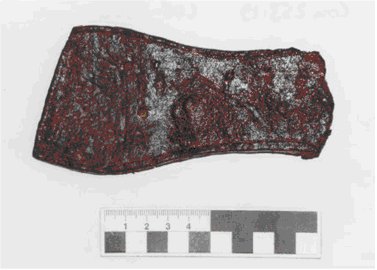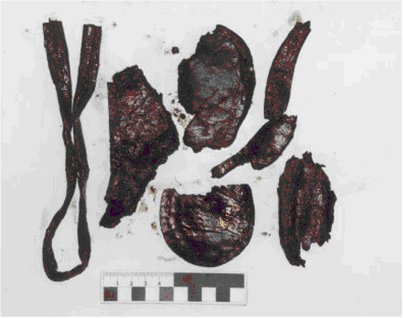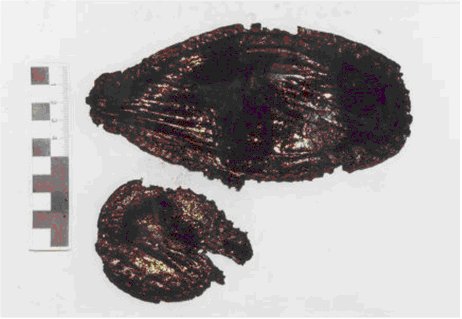Eyre Square leather
AUTHOR: Billy Quinn
Introduction
Forty four worked leather pieces were retrieved from the Market House excavation (for more on the excavation see here) during the course of the Eyre Square Re-enhancement Project between the 3rd and the 18th of November 2004. Most of the fragments were retrieved from a rectangular sondage (approx 8m x 2m) excavated across the centre of the site representing successive metalled surfaces and dump deposits pre-dating the eighteenth century building. The majority of the pieces would appear to come from post-medieval contexts consisting largely of footwear fragments and off cuts.

Find Number 04E1561:112:11 - Thread and waist piece from a shoe sole with well defined stitching possible late eighteenth century
Historical Context
The shoe styles found share similar characteristics with comparative urban excavations in Cork and Waterford and more locally from Barrack lane, Galway. The most common shoe type of the medieval period was the turnshoe, made as the name suggests by stitching a wet and inside out leather upper to a sole and then turning it rightside out so that the sewing is protected. The upper would then be wrapped around the foot and secured by either a strap, latched or using a thong. This simple template evolved through time for utilitarian purposes or simply as fashion dictated. Heels were initially made by sewing stiffeners inside the shoe to prevent wearing.
From the sixteenth century onwards heels developed into a series of separate “lifts” (“built heel”) stacked and pinned or sewed together. Similarly the upper changed from a simple wraparound piece to an overshoe consisting of a ‘vamp’ or toe covering, quarters covering the inner and outer sides of the foot, the tongue, a piece of leather to the front placed between two sides of a tied opening and the back strap. Another common shoe feature was a welt (sometimes called rand) or strip of leather stitched along the lasting margin between the upper and the sole to protect the seam and make the shoe watertight. Common shoes of the second half of the eighteenth century were the heavy brogue and the knee length boot. The native brogue (after the Irish bróga, meaning shoe) was a low heeled, heavy shoe of un-tanned leather with laces along the instep and no tongue with small perforations on the toe puff and quarters. This hardwearing footwear was practically designed for country men as a shoe that would drain water and dry quickly due to the lack of a tongue, and not get stuck in the mud because of their laces above the ankle. Knee length boots were an English introduction and were more expensive and associated with the landed gentry, given the restrictive laws for horse ownership during the penal law era.
Concerning leather as a raw material, cow hide was a generally used in the manufacture of most shoe soles, welts and binds – it being the strongest and most resilient of the available skins. For the uppers, calf, goat or sheep skin were the preferred choices for reasons of flexibility and comfort.
The Eyre Square Assemblage
Other than a few unidentified scraps, the bulk of the leather retrieved from the Eyre Square excavation was related to shoe making. A study of the fragments dated the majority of the finds to a period spanning the late sixteenth to eighteenth century. This determination was based on the complexity of the soles, the regularity of the stitching and the presence of stacked heels with lifts. This broad date stretching from the Nine Years War, through the Confederate Wars, and both the Cromwellian and Williamite campaigns up to the development of the Market House in the late eighteenth century is substantiated by both pottery and clay pipe fragments found in association.

Find Number 04E1561:127:39:1:9 Leather fragments including a welt fragment quarter section seat stiffener and heel piece
Given this time frame, and despite a lack of uppers, It can be assumed that the majority of the shoes were of the welted type, dumped when beyond repair outside the city walls in a local mire, known as as’ the pool’. This pool is depicted on the 1651 Galway pictorial map and now lies under the road surface to the north of the existing traffic island surviving as a rich organic, peaty layer containing frequent sea shells and fragments of animal bone.
All the leather retrieved from this layer was reasonably well preserved due to the compactness and anaerobic nature of the peat. However, on recovery the pieces were fragmentary and prone to decay, making handling difficult. Following excavation the finds were bagged and kept wet and with some of the surrounding material before being sent for conservation. In the laboratory the entire assemblage was cleaned in water then impregnated with a 20% v/v aqueous PEG 400 solution before being freeze dried and further treated with industrial methelyated spirit.
Generally the shoe fragments displayed a degree of sophistication indicating professional fabrication. This contrasts with the earlier turnshoe types that a relative amateur could make. The welted shoe would have required a shoemakers specialist equipment including lasts, awls, shears, knives, stitch pricks, stitching sticks, templates and of course the raw material leather and cord.

Find Number 04E1561:127:63 - Sole fragments double stitched thread and waist piece with seat piece
From a study of leather fragments found at other urban excavations, particularly from Cork and borne out at Eyre Square, there is a proportionate disparity between finds of soles to uppers. As previously mentioned soles are generally harder wearing due to their laminated manufacture and preference for cow hide.
Most of the Eyre Square sole fragments indicate a degree of wear and tear, however there was little evidence of patching or repair. This suggests that the soles were dumped when worn out and that the shoe uppers were possibly re-used and re-cycled by local cobblers. That cobbling took place at a local level is attested too by the retrieved off cuts. None of the Eyre square shoe soles were found intact – all were broken at the waist or in two or more parts. Four of the better preserved soles, find no’s. 04E1561:27:57, 04E1561:105:209 and 04E1561:22:127:1 & 2 consisted of single thread pieces with a variety of stitching styles. Find No. 04E1561:27:57 was distinctive as having a toe stiffener glued under the sole (see image 3). Both find no’s 04E1561:22:127:1 & 2 were relatively small with very thin sole waists suggesting a ladies or child’s shoe. Specimen no. 04E1561:27:63 was a larger shoe that originally had three laminated soles. Another well preserved piece was 04E1561:112:11 – this complete waist and thread piece was finely stitched along its edge and would have been separately attached to a toe and seat piece (see image 1).
None of the upper fragments were intact enough to inform a discussion on the styles of the assemblage. There was no evidence for laceholes or decorative work. Of the larger pieces recovered one, 04E1561:131:12 a roughly squared piece, had two distinctive lengthwise creases in the shape of an instep. This piece may have been a sock liner reinforcing the sole and quarters and underpinning the vamp. Find no 04E1561:131:13:2 consisted of a double laminated possible quarter with holes along the top edge for a draw string. This is evident from the gathered appearance of the edge.
The Eyre square leather assemblage represents finds typical of the post medieval period, a period when shoemakers defined their profession as artisans rather than simply leather workers. Shoemakers from the 16th century onwards evolved their wears from manufacturing simple turnshoes to more sophisticated designs such as the welted shoe, brogue and knee length boot mirroring styles seen throughout Britain.
It is not possible to determine on the basis of the finds whether or not the shoes were of local manufacture or were imported from outside Galway County. That shoemaking thrived as a local industry is however in no doubt. Twenty six percent of a random list of 120 voting eligible professionals on the Galway Freemans roll of 1832 listed their occupation as either shoe or brogue makers.
BIBLIOGRAPHY
Gleason G, O’Rourke D, ‘Leather’ in Fitzpatrick, O’Brien, Walsh (Ed.). Archaeological Excavations in Galway City 1987-1998. Wordwell, Dublin.
O’Rourke, D, 1997 ‘Leather finds’ in C. Walsh (ed.). Excavations at Patrick, Nicholas and Winetavern Streets, Dublin.163-178. Brandon.
O’Rourke,D. 1997 ‘Leather artefacts’ In M.F. Hurley, O.B.M. Scully and S.W.J. Mc Cutchon (eds). Late Viking Age and medieval Waterford: excavations 1986-1992, 703-42. Waterford.
Fitzpatrick, O’Brien, Walsh (Ed.). Archaeological Excavations in Galway City 1987-1998. Wordwell
Wincott Heckett, E. & Janaway, R.W. 1997 ‘Textiles, animal hair and fibres’ In R.M. Cleary, M. F. Hurley & E. Shee Twohig (eds). Skiddy’s Castle and Christ Church, Cork: Excavations 1974-77, 340-8. Cork.
Shoe puns welcome….. More small finds from Eyre Square coming soon…..
This entry was posted on Thursday, December 4th, 2008 at 4:54 pm. It is filed under About Archaeology, Papers & Reports, Virtual Museum and tagged with archaeological, archaeological consultants galway, excavation, Eyre Square, eyre square enhancement, Leather, report, shoe throwing, Shoes.
You can follow any responses to this entry through the RSS 2.0 feed.






All this talk of shoes has given me the horn.
Well you said all puns were welcome.
Shoe-rly you can do better than that!
I was going to write something else, but it lacked sole.
I admit that the article draws on the cultural values (shoemaking and reinvention of new shoe styles) of the epoch of the Middle Ages – a very fascinating age in ancient times!
The author of the article gives an incredible insight into the history of medieval shoemaking on the whole.
Many artifacts of antiquity (like shoes) did seem to be of a peculiar interest for people in the Middle Ages, which were also interested in developing the art of shoemaking throughout the centuries and could be considered the art of everyday life…when feudalism flourished and suppressed people to work.
Kind regards,
Tanya Shekhovtsova.
Thanks for your kind comments Tanya. The rest of us in the office do feel that Billy has developed a rather unhealthy fixation on shoes recently….
I would also admit that really appreciate reviews of excavations directed by Billy Quinn, which were carried out to the north of Eyre Square, in Galway.
I see that nu,erous findings described by the author demonstrate the level of proficiency of the people in the Middle Ages, their profound knowledge and skills.
As far as I know, most of the serfs in the Middle Ages had different occupations and thus shoemaking can also be regarded as a professional activity and part of their peasant’s job. It is an interesting subject for the research to be involved in.
My best wishes to you and Billy too!
Kind regards,
Tatyana.